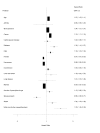Predicting nursing home admission in the U.S: a meta-analysis
- PMID: 17578574
- PMCID: PMC1914346
- DOI: 10.1186/1471-2318-7-13
Predicting nursing home admission in the U.S: a meta-analysis
Abstract
Background: While existing reviews have identified significant predictors of nursing home admission, this meta-analysis attempted to provide more integrated empirical findings to identify predictors. The present study aimed to generate pooled empirical associations for sociodemographic, functional, cognitive, service use, and informal support indicators that predict nursing home admission among older adults in the U.S.
Methods: Studies published in English were retrieved by searching the MEDLINE, PSYCINFO, CINAHL, and Digital Dissertations databases using the keywords: "nursing home placement," "nursing home entry," "nursing home admission," and "predictors/institutionalization." Any reports including these key words were retrieved. Bibliographies of retrieved articles were also searched. Selected studies included sampling frames that were nationally- or regionally-representative of the U.S. older population.
Results: Of 736 relevant reports identified, 77 reports across 12 data sources were included that used longitudinal designs and community-based samples. Information on number of nursing home admissions, length of follow-up, sample characteristics, analysis type, statistical adjustment, and potential risk factors were extracted with standardized protocols. Random effects models were used to separately pool the logistic and Cox regression model results from the individual data sources. Among the strongest predictors of nursing home admission were 3 or more activities of daily living dependencies (summary odds ratio [OR] = 3.25; 95% confidence interval [CI], 2.56-4.09), cognitive impairment (OR = 2.54; CI, 1.44-4.51), and prior nursing home use (OR = 3.47; CI, 1.89-6.37).
Conclusion: The pooled associations provided detailed empirical information as to which variables emerged as the strongest predictors of NH admission (e.g., 3 or more ADL dependencies, cognitive impairment, prior NH use). These results could be utilized as weights in the construction and validation of prognostic tools to estimate risk for NH entry over a multi-year period.
Figures



References
-
- The American Geriatrics Society Foundation for Health in Aging http://www.healthinaging.org/agingintheknow/chapters_print_ch_trial.asp?...
-
- Wunderlich GS, Kohler P, (Eds) Improving the Quality of Long-Term Care (Report of the Institute of Medicine) Washington, DC: National Academy Press; 2001. - PubMed
-
- Kane RA. Long-term care and a good quality of life: bringing them closer together. Gerontologist. 2001;41:293–304. - PubMed
Publication types
MeSH terms
LinkOut - more resources
Full Text Sources
Medical

